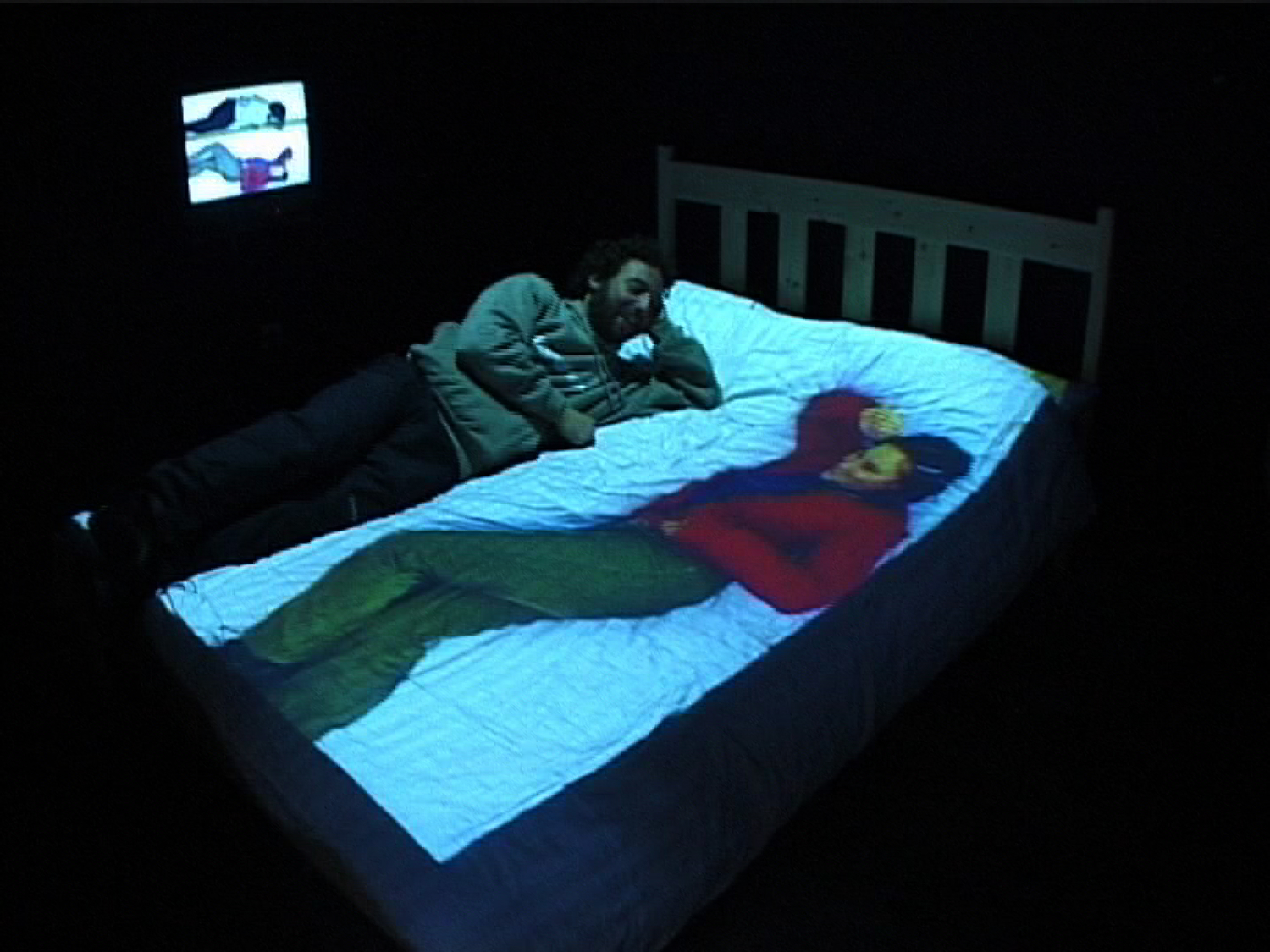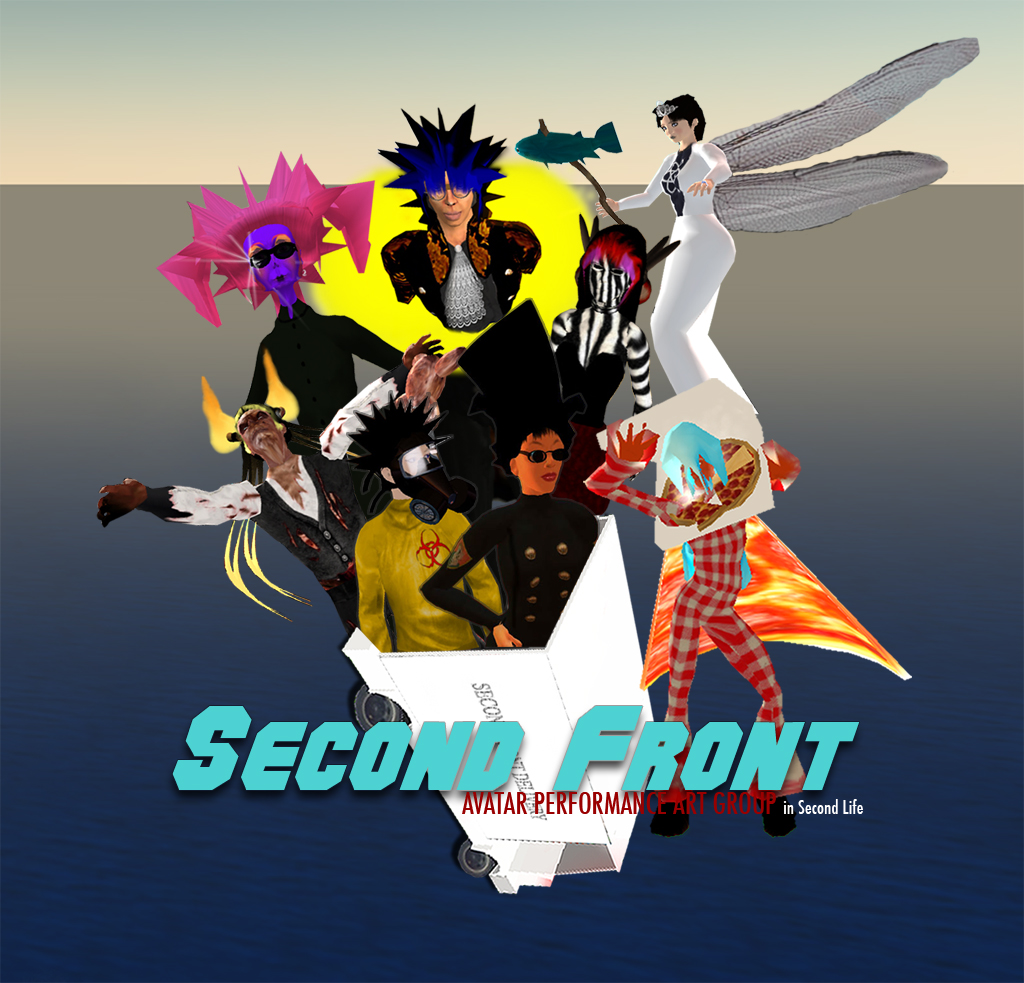The Third Space
Description
Week 5: September 10 – 16
The third space is defined as a shared electronic space with remote participants connected via the network: a concept fundamental to this course. We will explore the psychological and conceptual dimensions of the third space, notions of distributed presence, the dissolution of the object, disembodiment, the immaterial, and the intimacy of the telematic embrace. We will discuss third space forms of collective experience via the network through live media, remote location, mobility, transformations of geographical perception in time and space, and how the third space lends itself to artistic realization. We will review historical third space projects: networked art, satellite broadcasts, net.art, leading to contemporary works of online, installation, and performance.
Assignments
Due: September 17
Reading
Packer, R. & Cates J. (2014) “Glitch Expectations: Interview with Jon Cates,” Hyperallergic
Micro-Project V: Virtual Soundscape
Using only Soundcloud and a smart phone, narrate an approximately two-minute walk: no editing, cuts, or montage, a real-time recording. See Project Assignments for more information.
Research Post IV: Glitch Aesthetics
You will be assigned an artwork to research for a short written hyperessay about the work, the artist, and how it relates specifically to the topic of next week. Incorporate the reading (see above) for next week into your research, discussing how it relates contextually to the work. Post your hyperessay of approximately 400 words on your blog using relevant hyperlinks, images, video, etc, and remember to add a featured image and to use the “Research” category. You will be expected to share your research post in next week’s class discussion.
Next week’s Research Assignments (see lecture notes in Glitch Aesthetics syllabus page for additional information):
(1) Shar and John: Jodi.org, Dirk Paesmans & Joan Heemskerk (1995)
(2) Jun and Ruzana: Mark Napier, The Shredder (1997)
(3) MJ and Diana: Jon Cates, GL1TCH.US, (ongoing)
Outline
Adobe Connect Setup
- be sure connect add-in has launched
- go through audio setup wizard
- turn on microphone
- check microphone level (not too high), maybe 3/4
- turn on camera (share camera)
- check connection status
- test link “browse to”
- raising your virtual hand and other emoticons
Miscellaneous
- Use categories carefully, no uncategorized.
- Some themes seem very narrow, not responsive, what to do?
- Incorporate reading into research posts
Panel Discussion / Connecting People in the Post-Internet World: How are technologies and networks changing social behaviour?
Saturday, 13th September
7.30pm – 8.30pm
(Live + Web-conference, USA and SG)
This dialogue session is a program of ‘WHO’S LOOKING: SURF & TURF’, an inquiry into engagements with art in the age of the internet. As our attention ecology manoeuvres between the online and offline, the agency and spectatorship of art in real life (IRL) extends beyond the physical and durational, through their parallel lives on the web (URL). Artists in this exhibition undertake these modes of encounters, producing works that are framed for/by diverse online platforms.
Moderated by:
Randall Packer (Artist, Educator and Founder of Open Source Studio, OSS) via Adobe Connect.
Speakers:
Bernard Leong (Vice-President, Digital Services, Singapore Post Ltd)
Gilles Massot (Artist and Educator, Lasalle School of the Arts)
Huifen Zheng (Corporate Technology Lawyer)
Followed by Creative Mixer Afterparty 8.30pm – late
Complimentary cocktails by Reyka Vodka.
Sweet and savory bites by #tweedlebakes.
I am inviting everyone to join us for the web conference via Adobe Connect in our Virtual Classroom:
http://bit.ly/1trzhtK
or you can go down to Gillman Barracks and see the show and the panel in the first space:
Block #38, Post-PopUp at the Centre for Contemporary Art
Gillman Barracks
38 Malan Road, Singapore 109441
The exhibition is open 2 – 7 pm until Sunday, 14th September
Critique of the Data Visualization Micro-project
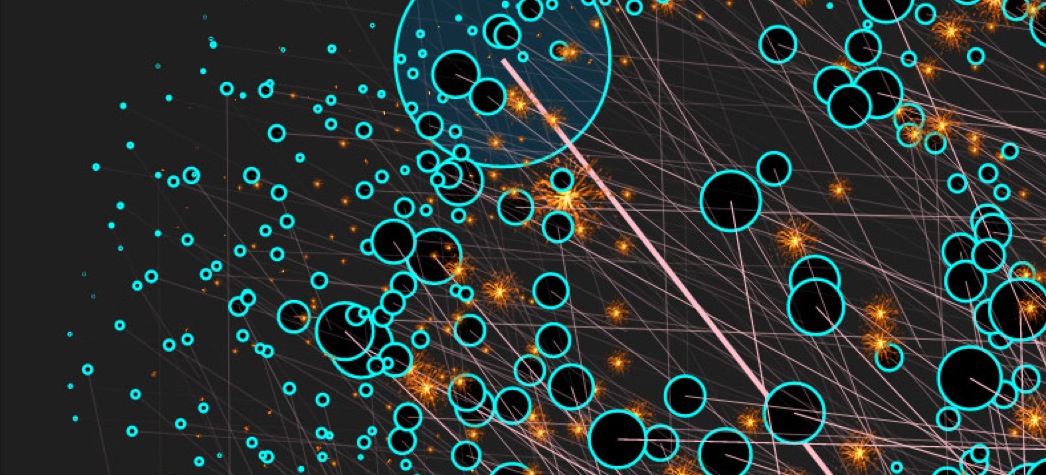
First, we will make sure everyone was able to complete their project according to the project assignment, to see if there are any questions or issues. We will also see if all the micro-projects can be embedded into the WordPress posts using the Codepen shortcode.
We will then discuss the results of the data visualization project using Facebook data as a means of understanding the dynamics of our virtual social relationships. What does the data tell us about ourselves, our friends, our connections with others? How do we integrate the aesthetics of our visualizations with the interpretation of their meaning? These are some of the questions we will ask as we review the works.
Collaborative Data Visualization Work for Final Project
Since we have until October 8 to hand in the first installment of the Project Hyperessay, a conceptual introduction to the Final Project, we thought it would be worthwhile to take some time in the remaining weeks to consider the viability and interest in a collaborative group final project. Based on the success of Juan’s data visualization exercise, I feel that the class is up to the task of taking on my more ambitious work that would be created collectively. If anyone feels strongly about creating an individual work, that is fine, because a collaborative work doesn’t need to involve the whole class, perhaps a smaller group. But I feel strongly that a group project would best fulfill the promise of OSS, in which we are learning Web-based tools for collaboration, and we are already working very closely with a sophisticated database for our research and assignments. So we will take some time to discuss the idea of what Roy Ascott calls a “gesamtdatenwerk” (total data work) and explore some possible outcomes of for a group data visualization project with multimedia dimensions. Here are a few ideas that we can brainstorm off of in the coming weeks:
- the final project could explore the idea of a collective Website, in which each student will create their own component, contribute such elements as code, images, sound, text, etc.
- the project would explore the Web as a spatial dimension, the visualization of data in a three-dimensional space, perhaps generated by the viewer, or data provided by the OSS network of users
- created as a projected installation in the ADM lobby for one or two days during the last week of the semester
- a space for user engagement, a space for exploring social relations, for visualizing / auralizing the OSS network, in which users would contribute data via mobile devices such as images, texts, sounds via Twitter, Instagram, Soundcloud, Facebook, etc., or grabbing information from the OSS network and placing images and other media into a three-dimensional configuration
- the work would be archived on the OSS class site with written contextualization / texts by collaborating students in our class
Concept of the third space
“The floating work of art is no longer the expression of a single individual. Neither is it the expression of a collective, but it is the stage of a “connective” – a web of influences that are continually reorganized by all participants.” – Soke Dinkla
The third space fundamentally represents the fusion of the physical (first space) and the virtual (second space) into a space that can be inhabited by remote users simultaneously or asynchronously. The hybrid notion of blurring the real and the virtual is expanded in the third space through distributed presence, in which the participants of the third space are in remote physical spaces. Essentially, we are referring to a shared electronic space, in which interaction takes place in space between the real and the virtual. As you can see, the third space extends the notion of the real and the virtual by creating a new kind of hybrid space that allows remote participants to interact both with the work, and with each other.
The third space is not a new concept: speaking on a telephone is a third space experience, or perhaps “phone space,” in which participants are joined together electronically from remote locations for purposes of communication. Watching a movie is not a third space experience, because all of the viewers are watching from the same physical space. However, Adobe Connect is a third space environment, as we use the shared space of the interface to interact, view one another, chat, and give presentations: all while remotely distributed. The third space does not need to be live, it can be realized and experienced asynchronously, such as a Web-based discussion forum or even email and texting, however, the experienced of exchange and participation is heightened when the interaction is live and in real-time.
For our study of the third space, we begin by holding our class in the third space in order to engage in what I like to refer to as a “visceral experience of the virtual.” Perhaps the best way to understand the concept of the third space is to learn, work, and create in this distributed space. Although we are all remotely “jacked” into the network (to coin a term from cyberpunk writer William Gibson), we can inhabit this space together: talk, exchange ideas, smile, laugh, and conduct a class that is nearly the same as one held in the physical space. While we are not physically present, we are in fact *together* in the third space. As the world becomes increasingly networked and digital, this is the reality of the future, and the future is here.
“Performance companies may use this virtual hole in reality not to differentiate the two realities but to combine them. Using the doubling of space synergistically to demarcate a new unified “mixed reality” space.” – Slavoj Zizeki, “Holes in Reality”
Reading: Rabinowitz, S., Galloway, K. (1992). “Welcome to ‘Electronic Café Interntional” in Packer, R., & Jordan, K. (Eds.). pg 345-351, Multimedia : from Wagner to Virtual Reality ([Expanded ed.). New York: Norton.
“If there is one word that defines Electronic Cafe, it is integration, Integration of technology into our social fabric; integration of distinct cultures and communities, the arts, and the general public; and integration of art forms.”
“We create a culture that defines how the technology can be used and encourages cross-cultural collaborations, problem-solving, and decision-making.”
“A virtual space creates social situations without traditional rules of etiquette.”
Despite the speed of transmission of images in the original period of the Electronic Cafe, the idea was seminal: to connect people, cultures, ideas, and art across geographical distances, collapsing space, and catalyzing opportunities for collaboration and collective forms.
The following are artworks spanning over 30 years that embody the idea of the third space. Our discussion will be led by the following students/works:
(1) Shar and MJ: Hole in Space by Kit Galloway and Sherrie Rabinowitz
(2) John and Ruzana: Telematic Dreaming by Paul Sermon
(3) Jun and Diana: The Kiss by Annie Abrahams
Hole in Space, Sherrie Rabinowtiz & Kit Galloway (1980)
Kit Galloway and Sherrie Rabinowitz, founders of the Electronic Café in Santa Monica, California, were among the first artists to begin exploring communications art through satellite technologies. Their seminal work, Hole in Space from 1980, represented one of the earliest examples of live, networked media art. They setup two large projection screens: one at Lincoln Center in New York, the other at Century City in Los Angeles to connect two audiences. Conceived as a participatory event (much like the early Happenings), this unannounced project, setup for three consecutive days, enabled two groups of viewer to see the other live and in real-time across the space of the US, which literally collapsed the experience of the real and the virtual, the local and the remote.
From Media.Art.Net: Hole in Space was a Public Communication Sculpture [for three days]. On a November evening in 1980 the unsuspecting public walking past the Lincoln Center for the Performing Arts in New York City, and The Broadway department store located in the open air Shopping Center in Century City (Los Angeles), had a surprising counter with each other. Suddenly head-to-toe, life-sized, television images of the people on the opposite coast appeared. They could now see, hear, and speak with each other as if encountering each other on the same sidewalk. No signs, sponsor logos, or credits were posted—no explanation at all was offered. No self-view video monitors to distract from the phenomena of this life–size encounter. Hole–In–Space suddenly severed the distance between both cities and created an outrageous pedestrian intersection. There was the evening of discovery, followed by the evening of intentional word-of-mouth rendezvous, followed by a mass migration of families and trans–continental loved ones, some of which had not seen each other for over twenty years.
Kit Galloway and Sherrie Rabinowitz, founders of the Electronic Café in Santa Monica, California, were among the first artists to begin exploring communications art through satellite technologies. Their seminal work, Hole-in-Space from1980, represented one of the earliest examples of live, networked media art. They setup two large projection screens: one at Lincoln Center in New York City, the other at Century City in Los Angeles, to connect two audiences. Conceived as a participatory event (much like the early Happenings), this unannounced project, setup for three consecutive days, enabled two groups of viewers to see the other live and in real-time across the space of the US, which literally collapsed the experience of the real and the virtual, the local and the remote.

Four years later, Galloway and Rabinowitz founded the Electronic Café in a project commissioned by the LA Museum of Contemporary Art in conjunction with the 1984 Olympics Art Festival in Los Angeles. The event joined five restaurants in LA situated in diverse neighborhoods: effectively opening up a “hole in space” between ethnic groups of geographically distant and separate communities. People at the cafés could exchange drawings, photos, poems, and messages via a dedicated network. The Electronic Café was essentially the prototypical “cyber café,” nearly ten years before the Web would become a mass medium. The artists’ commitment to using technologies to enhance community interaction led them to establish a permanent space in Santa Monica, where the Electronic Café became internationally known as a center for events, exhibitions, and performances dedicated to communications art.
Telematic Dreaming, Paul Sermon (1993)
Artist Statement: Telematic Dreaming was originally produced as a commission for the annual summer exhibition curated by the Finnish Ministry of Culture in Kajaani, with support from Telecom Finland, in June 1992.
Within the third space, two participants lie on beds in remote locations, but together they share a bed in electronic space. Although they are not physically together, there is a strong sense of intimacy and shared presence between the participants. This piece directly questions the sense of intimacy experienced in the third space: the “telematic embrace” of individuals united via the network. When you “touch” another individual in the third space, why do you feel a connection as though you were physically present? Why is there a sense of intimacy in the third space, even though you are remote from the other person(s). Telematic Dreaming asks these questions while looking forward to how we are increasingly engaging with one another and forming relationships in the third space.
Artist Statement: Telematic Dreaming is an installation that was created within the ISDN digital telephone network. Two separate interfaces are located in separate locations, these interfaces in themselves are dynamic installations that function as customized video-conferencing systems. A double bed is located within both locations, one in a blacked out space and the other in an illuminated space. The bed in the light location has a camera situated directly above it, sending a live video image of the bed, and a person (“A”) lying on it, to a video projector located above the other bed in the blacked out location. The live video image is projected down on to the bed with another person (“B”) on it. A second camera, next to the video projector, sends a live video image of the projection of person “A” with person “B” back to a series of monitors that surround the bed and person “A” in the illuminated location. The telepresent image functions like a mirror that reflects one person within another persons reflection.
“Telematic Dreaming” deliberately plays with the ambiguous connotations of a bed as a telepresent projection surface. The psychological complexity of the object dissolves the geographical distance and technology involved in the complete ISDN installation. The ability to exist outside of the users own space and time is created by an alarmingly real sense of touch that is enhanced by the context of the bed and caused by an acute shift of senses in the telematic space. The users consciousness within the telepresent body is controlled by a voyeurism of its self. The cause and effect interactions of the body determine its own space and time, by extending this through the ISDN network, the body can travel at the speed of light and locate itself wherever it is interacting. In “Telematic Dreaming” the user exchanges their tactile senses and touch by replacing their hands with their eyes.
Second Front, Grand Theft Avatar (2008)
From the project Website for Grand Theft Avatar: Second Front robs the Linden Treasury acting as the “currency liberation army.” In a live performance at the San Francisco Art Institute as part of the “From Cinema to Machinima” panel, we impersonated the members of the panel, walked in on Patty Hearst, the receptionist, grabbed the loot and freed it. In a final act of desperation, we rode H-bombs, Slim Pickens style (Stanley Kubrick’s film Dr. Strangelove) into the sunset.
Since the graphical antics of the Palace, Second Life has set the stage for performance events that create nearly believable worlds. While still in the realm of simple animation, Second LIfe provides a multi-user environment for dramatic action, character development, unusual gestural movement, spoken lines, sound effects, and lavish set design. In Grand Theft Avatar, the Second Front company of avatar-actors sabotages Second Life’s monetary system, by robbing the “Linden Treasury” of virtual dollars, the currency actually used commercially by those who inhabit the space. This work is an example of artistically critiquing game structure, in which artists stage counter-narrative that undermines more traditional game structure, while at the same time, commenting on the social and political nature of game strategies.
Second Front is the first performance art group in the online virtual world of Second Life. Founded in 2006, Second Front quickly grew to its current seven-member troupe that includes Gazira Babeli (Italy), Yael Gilks (London), Bibbe Hansen (New York), Doug Jarvis (Victoria), Scott Kildall (San Francisco), Patrick Lichty (Chicago) and Liz Solo (St. Johns).
The Kiss (2007)
Annie Abrahams
French performance artist Annie Abrahams uses webcam technology to unite participants in a shared electronic space. In this work, the two performers attempt to kiss through the network. Despite physical separation, there is a sense of intimacy in the telematic embrace. We ask the question: are we “alone together,” or are we able to form meaningful and deeply human connections through networked interaction and performance.
This work explores the idea of the “telematic embrace,” a concept discussed by theorist Roy Ascott in terms of qualities of engagement in networked space. Here, cyberperformance artist Annie Abrahams explores the integration of two physical spaces as sets for a “still life,” in this case: a third space still life since the integration of these elements is only possible in this hybrid electronic space. As the performers combine their telematically connected bodies in the third space, they attempt to reach through the digital divide, to explore a kind of extended human presence across the network. Is this what we experience when we are engaged in a Skype conversation?
From Annie Abrahams essay, “Trapped to Reveal“: Earlier telematic projects such as Sherrie Rabinowitz and Kit Galloway’s Hole in Space (1980) and Electronic Café International (1984) [5] or Paul Sermon’s Telematic Dreaming (1992) [6] did explore relational possibilities in machine mediated environments, but paid little attention to it’s moments of failure or it’s messiness as integrated parts of the relation. I felt it was time to explore the relational conditions and behaviour of humans living in an increasingly technologized society again.
In works such as Shared Still Life, according to Maria Chatzichristodoulou from the exhibition at the Futherfield Gallery in London, “the work is commonplace, messy and malleable. It is about the ‘banal’ reality of everyday life, time passing by, people crossing paths in fractured, desperate or indifferent attempts to communicate. This everyday quality opens up Abrahams’s Shared Still Life to movement, dust, miscommunication, and shared absence.”
Some questions to consider at the close of our study of the third space:
- How does this work predict future life in the third space?
- Are we increasingly attempting to navigate this space as part of our everyday lives?
- Is the third space becoming a replacement of so-called real life in the physical world?
- Do we prefer life in the third space to life in the first space?
For those students who may be considering a third space performance, here are some interesting technical / conceptual questions to consider, when performers are alone together, from Trapped to Reveal:
- They are connected, using a webcam, to a shared interface where they can see images and hear the sounds from all the other performers and themselves.
- This interface has the form of a grid.
- They share image boundaries and can interact spatially with the other performers.
- The sound the performer hears is a mix of all the sounds from the other performers.
- Because of network delays the way the interface has been constructed, no two performers receive the same images and sound at the same time.
- To avoid delay – difficulties while speaking, performers cannot hear their own voices, and cannot judge their participation in the total sound environment.
- The performers must wear a headset to avoid feedback.
In closing, a performance by Annie Abrahams, Huis Clos / No Exit – Tout va Bien
for the “Self-Reflexivity and Cinéma Verité” session curated by Martine Neddam
Studium Generale from 2011 “Cinema Clash Continuum – Film & History in the age of Godard”
30 March 2011, Rietveld academy, Amsterdam
With Balthazar Berling, Lola Bezemer, Rozemarijn Hermans,Tirza Kater, Alexander Laurie and Anna Orlikowska
What does a work such as Huis Clos / No Exit – Tout va Bien suggest for the future of cinema in the third space? How might we construct cinematic structures in the third space? Instead of cinema articulating a singular vision, how can third space cinema create a mosaic of visions, a grid of point of views, a composite of cinematic ideas?
Margaret Wertheim , author of The Pearly Gates of Cyberspace, announces that with networked cyberspace, “We are witnessing here the birth of a new domain, a new space that simply did not exist before.”
Collective Third Space Compositions by Yeo Jin Xiang
The following images were created in Adobe Connect, connecting bodies in the third space from remote locations.
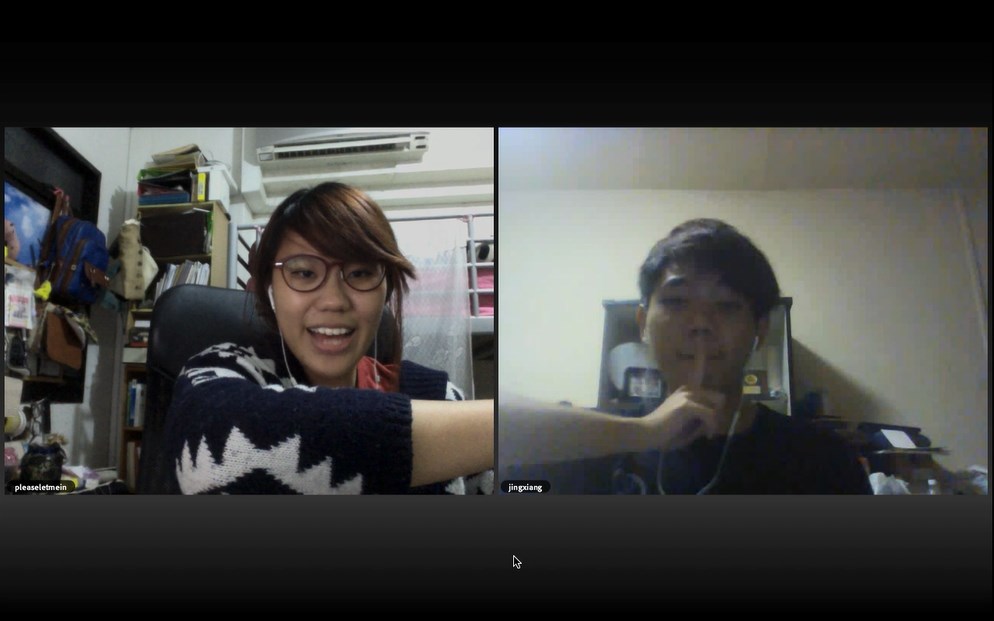
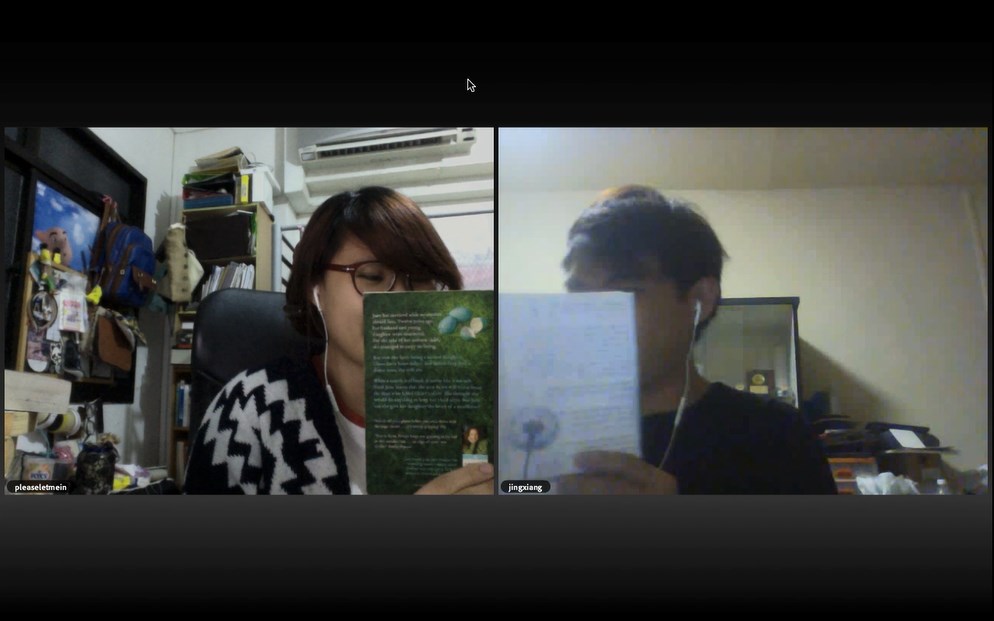
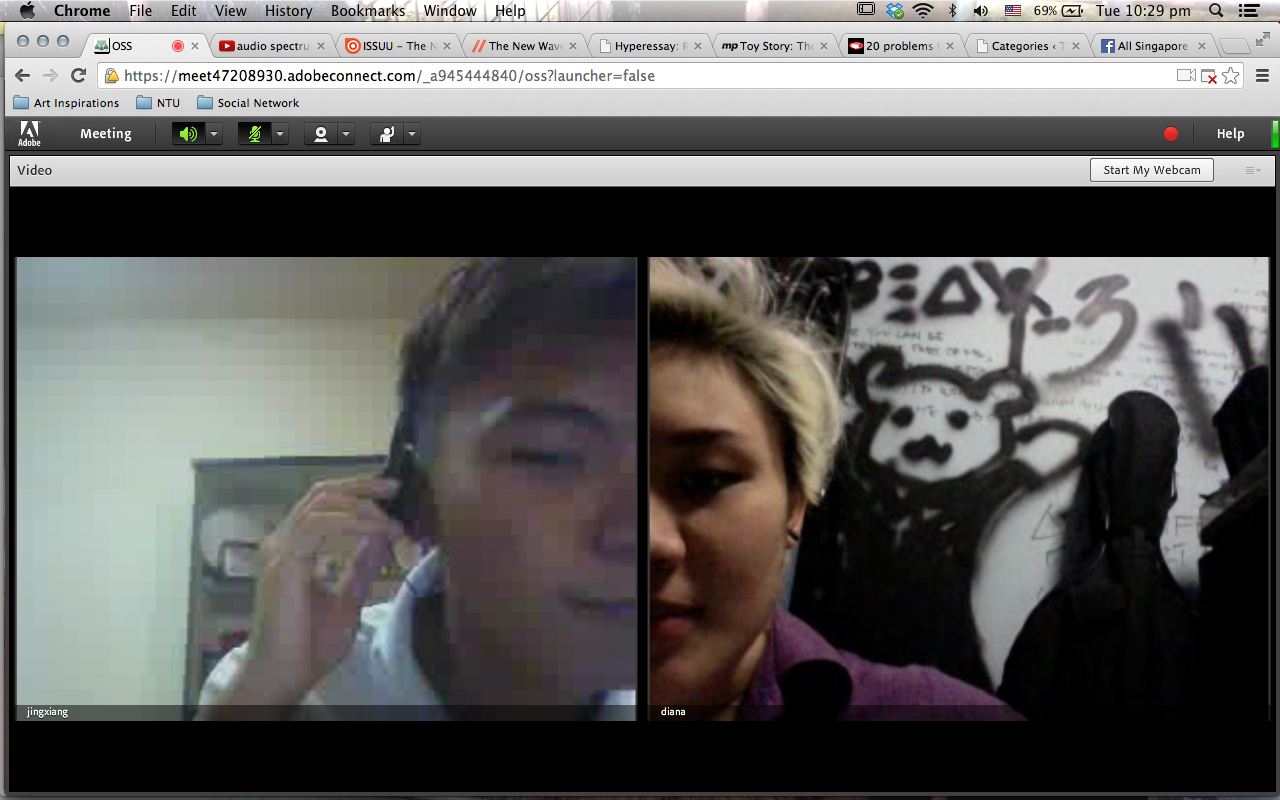
Review assignments for next week

